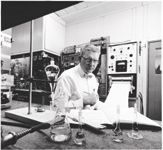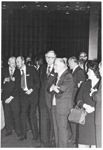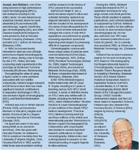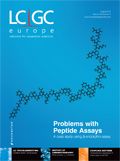Joseph Jack Kirkland: HPLC Particle Pioneer
"HPLC Particle Pioneer" Joseph Jack Kirkland answers questions from Gert Desmet on his pioneering career in chromatography and his interest in superfi cially porous particles (SPPs).
Joseph Jack Kirkland answered questions from Gert Desmet on his pioneering career in high performance liquid chromatography (HPLC).
Gert Desmet: How did you enter the field of chromatography?
Joseph Jack Kirkland: In the late 1950s I began to use gas chromatography (GC) to solve problems relating to agricultural products that were being developed at DuPont. This effort was triggered by interactions with Dupont's Dr Steve Dal Nogare who started the early studies in GC, especially in programmed temperature operation. GC analyses proved to be quite useful, but there were many compounds of interest to Dupont that were not volatile and could not be separated by this technique.
In some cases I was able to derivatize these materials to produce structures that were sufficiently volatile for GC analysis, but many problems still remained that needed a solution. Around 1960, I attempted liquid chromatography (LC) separations of some non-volatile compounds using large-particle silica gel columns as the separating medium, a low pressure pump, and a refractometer as a detector. Crude separations resulted, but it was too slow, poorly reproducible, and very frustrating. I really did not know enough to create the desired result. Therefore, this project was not pursued further. However, in 1964, when I was visiting Europe, during a trip to Eindhoven, I came across Dr Joseph (J.F.K.) Huber in a laboratory performing what we now call high performance liquid chromatography (HPLC).
Joseph was using a constant pressure pump (1000 psi), a small diameter column with ~50 µm diatomaceous earth particles, and a ultraviolet (UV) spectrometer that had been converted into a crude detector. With this arrangement, Joseph was demonstrating remarkable (for that time) separations of non-volatile compounds using a liquid-liquid chromatographic technique. This visit was so interesting that on my return to DuPont, I approached my supervisor and pleaded for the time and resources to begin a programme into researching HPLC technology. This request was approved and I then started to develop the materials that were needed to make the technique routine. To improve the technology, I believed that a better column packing was required, together with a reliable and highly-sensitive UV detector. Both of these items were subsequently developed, put into use, and a patent and papers on them published.

Figure 1: Jack Kirkland in his laboratory in 1960.
GD: Who were the people that most influenced your scientific and professional life and work?
JJK: There have been many important people in my life that have strongly influenced the paths that I have taken and the things that I have done along the way. R.A. Day, professor of analytical chemistry at Emory University (Atlanta, Georgia, USA) opened my eyes to the possibilities of analytical chemistry. He encouraged me in many ways so that I was later able to acquire a doctorate (at the University of Virginia, Virginia, USA) that better equipped me for research activities.
Dr Ralph K. Iler hired me into DuPont, which resulted in a strong personal friend and a world-class mentor in the science of colloids, especially silica. My efforts in developing silica supports for HPLC have largely grown out of my association with Ralph Iler. Dr Joseph J. DeStefano, long-time friend and co-worker, has largely been the driving force for any entrepreneurship that I might have shown, always encouraging basic studies that have resulted in commercial products for chromatography. The publications and friendship with Professor J. Calvin Giddings were key factors in my (partial) understanding of the basics in chromatography and for my research in field-flow fractionation (FFF) during the 1980s. Dr Lloyd R. Snyder has been a strong personal friend and co-worker for more than 40 years. Lloyd and I have participated in research, published papers, written several books, and delivered HPLC training courses together. To this day, we still discuss HPLC results and developments. It is important to say that Lloyd has had a crucial influence on my career and on many developments in HPLC that I have made. Finally, my wife, Karin Monson Kirkland, has always been a key factor in my life and my career. Also a chemist, Karin has been a strong advocate, a sharp technical critic, and a patient and tireless reviewer of ideas.

Figure 2: Jack Kirkland, Dr Joseph L. Glajch, and Dr Lloyd R. Snyder in 2008.
GD: What do you consider as the major breakthrough in the field that happened during your career?
JJK: The development of optimized particles and stationary phases have made HPLC a major analytical technique. This development has occurred slowly but surely over the past 50 years, with the efforts of many diligent scientists. For example, for me, first-of-a-kind commercial developments during this period included Zipax superficially porous particles in 1968, Permaphase (E.I. duPont de Nemours) bonded phase packings in 1970, Zorbax (E.I. duPont de Nemours) porous silica microspheres in 1972, Zorbax Rx (E.I. duPont de Nemours), Type B silica (E.I. duPont de Nemours) in 1989, and sterically-protected silane stationary phases in 1990 (with Dr Joseph L. Glajch). Resurrection of superficially porous particles began with a 1992 production of 7-µm wide-pore superficially particles. This was followed by 5-µm Poroshell-300 (Agilent Technologies) particles in 1997 and Halo (Advanced Material Technology) sub-3 µm superficially porous particles (often called core–shell, porous shell, or Fused-Core [Advanced Material Technology] particles) in 2006. However, probably the most active user response was after the introduction of Zorbax (E.I. duPont de Nemours) porous silica microspheres which are still commercial. Many other scientists, both academic and industrial, have made important developments in column packings that resulted in the prominence of HPLC today.
Equally important in breakthroughs have been developments in the marriage of HPLC with mass spectrometry (MS). These exciting developments (for which I essentially had no input) have crystallized the benefits of HPLC separations and enormously widened the scope of the method so that now the opportunities for utility in many areas are virtually unlimited.

Figure 3: Jack Kirkland discussing silica chemistry with U.S.S.R. Professor A. V. Kiselev at a conference in Tallin, Estonia, 1982.
GD: Which decisions or changes in your career would you certainly make again and which not?
JJK: It would have been an advantage if I had concentrated more on training in mathematics during my schooling. In some ways I focused more on obtaining a general education and this left time too short to develop the mathematical skills that would have made my scientific career more fruitful. Other than that, I am happy with the decisions that I made along the way, and would probably not change any major movements in my career.

Figure 4: Voges Mnt. prior to the HPLC symposium in 1983. Left to right is Professor Goran Schill, Professor Milton Hearn, Karin Kirkland, Jack Kirkland, Professor Klaus Unger, and Dr Johann Kraak.
GD: Did your work in industry slow down your scientific career or was it the opposite? Would your work have been much less influential if you had done your work in an academic environment?
JJK: My work in industry actually made it possible to develop my scientific career. Formative years at Hercules Powder Co. and then later at Dupont (after my doctorate) were spent solving difficult practical problems. This sharpened my focus and resulted in my learning how to obtain the required data to successfully meet a particular project goal. During that time, I gained experience in technologies such as polarography, infrared, and UV spectroscopy and colorimetric analysis of trace organic components, all of which broadened my analytical skills.
I was particularly fortunate to have worked in Dupont during the "golden days" of research. Because of the extraordinary resources at DuPont available for virtually all areas of chemical science, I was able to do things that were only possible at this institution. Within DuPont, I could find experts in almost all areas of chemistry, engineering, and bioscience to assist and mentor me. Much of my research in separations in later years was commercialized by DuPont, which enhanced my experience in the practical, utilitarian world. As mostly a pragmatic, practical-minded person, industry was an excellent fit for me and I did not have to spend time attempting to secure grants and other funds to support my research.
I was also able to secure and train excellent technicians who were with me for a long time to assist in projects. One technician (Charles Dilks, Jr.) worked with me for 25 years including during my time at DuPont and later when I was with Rockland Technologies, Hewlett Packard, and Agilent Technologies. All of this experience has contributed to my research activities at Advanced Materials Technology that is my current (and last) challenge. I have also actually sampled the academic world as an adjunct professor at the University of Delaware (Delaware, USA), and during the 21 years that Lloyd Snyder and I taught courses in HPLC for the Continuing Education Department of the American Chemical Society. These experiences were interesting and challenging but I am better suited, and my interests and experience are better fitted, to the industrial world.

GD: What are in your opinion the most critical elements to produce a good silica particle and column (material purity, coating, column loading, and so on)?
JJK: Several important factors are involved in forming a high-efficiency, stable column. Good columns for many compounds require the use of Type B high-purity silica for good peak shapes and high efficiency. Techniques for reactions needed for the effective bonding of stationary phases are now well-known and widely published. Once the stationary phase is loaded to this silica support, the column packing method is most critical. Column packing techniques are a combination of science and art. This results from the lack of knowledge of how many unknown factors are involved in forming an efficient, stable packed bed after all these many years of developments. Manufacturers typically do not publish their experiences with column-packing techniques, but a few articles have been published with useful information (5).
GD: You are the founding father of the porous-shell technology. How proud does that make you?
JJK: As with many developments in science, my efforts in superficially porous (porous shell) particle technology were catalysed by previous studies. Csaba Horváth and Sandford Lipsky first made pellicular ion-exchange particles by sorbing small ion-exchange particles to the surface of glass beads. These pellicular particles were interesting to me, but had limitations in sample loading properties because of very small surface areas. When I began studies in HPLC, I recognized that new particles were needed to enable better column performance (at that time, large irregular diatomaceous earth particles used for GC were used to make HPLC columns). Ralph Iler had demonstrated the layering of silica sol particles to form porous films that exhibited light refraction. By marrying pellicular technology with the Iler layering method, I was able to come up with ~ 30-µm spherical particles with solid cores and an outer porous shell which were used and subsequently patented. These were successfully commercialized by DuPont as Zipax (E.I. duPont de Nemour) superficially porous particles (SPPs) as the first column packing materials specifically designed for HPLC. These SPPs were initially used in columns for liquid-liquid chromatography. However, subsequent development of Permaphase-bonded phase packings (with Dr Paul C. Yates) led to the development of the now widely-used reversed-phase techniques pioneered by DuPont's HPLC Applications Laboratory in the Instrument Products Department. With the development of the much smaller and more efficient porous silica microspheres such as Zorbax (E.I. duPont de Nemour) in the early 1970s, the larger Zipax (E.I. duPont de Nemour) particles quickly lost favour. More than 20 years passed before there was a rebirth of SPP.
However, during this period, I was still interested in the potential of porous-shell particles, and was able to do some research in this area that resulted in a patent for making particles by spray drying. A SPP designed for size-exclusion chromatography was also developed in the middle 1970s, disclosed in a patent but not commercialized. In 1992, I published a paper on the properties of a wide-pore 7-µm SPP made by spray drying and designed for separating peptides and proteins. A similar 5-µm product made by another method was commercialized as Poroshell-300 while working at Agilent in 1997. After beginning research at Advanced Materials Technology in 2005, the vision for how to make a small SPP took place, and as a result, the porous-shell (Fused-Core [Advanced Material Technology]) 2.7-µm particle called Halo (Advanced Material Technology) was developed. The success of these SPPs has resulted in the proliferation of these materials by competing manufacturers, and this technology has now been established as a major force in HPLC. This situation gives me great pleasure as it vindicates my long-time interest and belief in the chromatographic capabilities of particles with a non-porous core and a thin porous outer shell.

GD: What does it take to make a major scientific breakthrough? Perseverance or rather a flash of inspiration? Or just plain luck?
JJK: In my experience, breakthroughs are a combination of perseverance and luck. To be on the right track, one has to have the notion of what is needed and some ideas of how it might be accomplished. The rest is hard work to come up with feasible hypotheses, then devise and run the experiments that will ultimately allow the goal to be reached. In my career, I have had only one "flash inspiration" that resulted in a success. The rest of the time it has been a grind. Even when the work is a scientific success, it may not find utility or a commercial outlet. Therefore, luck and timing plays a large role in obtaining what might be termed as a "breakthrough". I once thought that with my astute co-worker, Dr Wallace W. Yau, we might have a "breakthrough" when we were able to develop a sedimentation field flow apparatus for operation up to 100,000 g. This unique apparatus and new exponential force decay technique allowed the gentle separation of a very wide range of particles and soluble materials, including proteins and other such sensitive large molecules with good resolution. Unfortunately, this published development was too early for general acceptance and this high force field technology languishes to this day — no luck!
GD: You have had a career which is full of entrepreneurship. Did you do this for the thrill of the entrepreneurship or the love of the product that you wanted to make?
JJK: Early work within DuPont was initiated to develop unique technology for solving some of the difficult problems in agricultural and industrial chemistry for which I was presented. I was able to do some basic research during this period, and this continued full-time when I transferred to DuPont's Central Research Department in 1973. My later work in industrial laboratories was more directed towards developing new products that would have commercial interest. Therefore, my later years involved some entrepreneurship, especially as a partner in Rockland Technologies (formed in 1989 and sold to Hewlett Packard in 1995). However, I still do research because it is my first love, although the hope is that results will justify commercialization of a product with practical utility for scientists.
GD: Where do you think the R&D departments of the major instrument and column manufacturers should invest most in? What new technology could revolutionize the way that we do our separations and analyses?
JJK: Some believe that research in HPLC is becoming too redundant and that there is little to gain from continuing efforts. Actually, there is still much left to do, although true "breakthroughs" are becoming more difficult. Most of any new developments in new HPLC technology will probably be in the life sciences for large molecules, for here is where many important challenges remain. I am still enamoured with the possibilities for FFF methods, for this family of separation methods are really best suited for large macromolecules, both natural and synthetic. I felt this in the 1980s, during which I largely spent my time researching these methods, and this feeling has not subsided. The problem was that my research (and the even more extensive research by Cal Giddings) was just too early; the macromolecular, especially the bioscience community, was not ready for these developments. FFF has not reached the expected important utility because the larger instrument companies have not applied the required long-term effort and resources to make these methods into a broad commercial success. Smaller FFF instrument manufacturers have created a resurgence which gives hope that this technology will finally attain the prominence that it deserves.
References
(1) J.J. Kirkland, Ed., Modern Practice of Liquid Chromatography, (Wiley-Interscience, New York, USA, 1971).
(2) Lloyd R. Snyder, Joseph J. Kirkland, and Joseph L. Glajch, Practical HPLC Method Development, second edition, (John Wiley and Sons, New York, USA, 1997).
(3) Lloyd R. Snyder, Joseph J. Kirkland, and John W. Dolan, Introduction to Modern Liquid Chromatography, third edition, (John Wiley and Sons, Hoboken, New Jersey, USA, 2010).
(4) Andre M. Striegel, Wallace W. Yay, Joseph J. Kirkland, and Donald D. Bly, Modern Size-Exclusion Liquid Chromatography, second edition, (John Wiley and Sons, Hoboken, New Jersey, USA, 2009).
(5) J.J. Kirkland and J.J. DeStefano, J. Chromatogr. A 1126(1–2), 50–57 (2006).

Polysorbate Quantification and Degradation Analysis via LC and Charged Aerosol Detection
April 9th 2025Scientists from ThermoFisher Scientific published a review article in the Journal of Chromatography A that provided an overview of HPLC analysis using charged aerosol detection can help with polysorbate quantification.
Removing Double-Stranded RNA Impurities Using Chromatography
April 8th 2025Researchers from Agency for Science, Technology and Research in Singapore recently published a review article exploring how chromatography can be used to remove double-stranded RNA impurities during mRNA therapeutics production.













